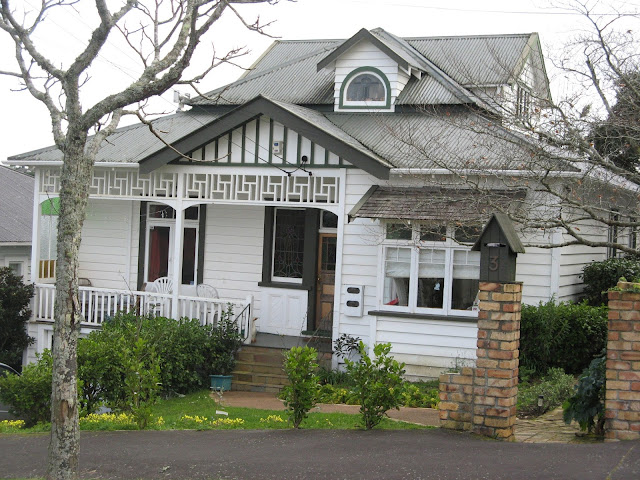In the early days of settlement New Zealand was a largely rural society with most people living in small cottages. As cities grew and suburbs developed, people became more affluent and looked for larger and more permanent homes, which the Villa provided. Drawing on Victorian influences the Villa was ornate and decorative having its heyday between 1880 and up to the start of the first World War when austerity measures were adopted.Villas were built entirely of wood with metal roofs, and often pre fabricated, floor plans were usually chosen from a catalogue. They featured high ceilings, sash windows and wide hallways and decorative features included stained glass windows, lacy fretwork and turned finials on the roof.
 |
| A two storied Villa with all the usual features; finials, ornate fretwork, wrap around verandahs and stained glass |

 They were not built for the sun, with the master bedroom and little used, formal, parlour facing the road regardless, which, together with being uninsulated, made Villas cold and draughty. Different cities in New Zealand had slightly different styles of villa, for example, in Auckland's warmer climate large wrap around verandahs were a feature, in Wellington Villas tended to be narrower and in Dunedin wrought iron was used as a decorative finish. They did not have running hot water and in the early days, as was normal for the times, the toilet was a long drop in the garden. Later the toilet was moved to the main house but was usually located at the end of a back verandah which meant going outside the house and along the verandah whatever the weather, an improvement on having an outhouse in the garden, at least.
They were not built for the sun, with the master bedroom and little used, formal, parlour facing the road regardless, which, together with being uninsulated, made Villas cold and draughty. Different cities in New Zealand had slightly different styles of villa, for example, in Auckland's warmer climate large wrap around verandahs were a feature, in Wellington Villas tended to be narrower and in Dunedin wrought iron was used as a decorative finish. They did not have running hot water and in the early days, as was normal for the times, the toilet was a long drop in the garden. Later the toilet was moved to the main house but was usually located at the end of a back verandah which meant going outside the house and along the verandah whatever the weather, an improvement on having an outhouse in the garden, at least. |
| My Grandparents house, a later version - the Transitional Villa. The only change is the top floor, added by new owners. |
Today Villas are highly sought after although they need to be extensively altered to suit modern lifestyles. The key to a successful renovation is to retain the exterior (as seen in the photos above) while altering the layout inside. Villas epitomise the romantic dream of a house a garden and a white picket fence. At the time they were built cities were very small and villas were out in the new suburbs. Today, as the cities have grown, those suburbs are mainly central city. Partly because of their central location and partly because they are a beloved style of architecture in New Zealand a well refurbished Villa is now very expensive.
 |
| A modernised Villa, adapted for modern living but retaining many original features. |
Examples of Villas are spread throughout the inner suburbs of Auckland but some suburbs have more than others. Devonport and Cheltenham are two of the best but they can be found in numbers in Herne Bay, Ponsonby, Parnell, Remuera (where my grandparents lived) and Epsom.
All photos are my own




No comments:
Post a Comment